There just hasn’t been any real work done on sooty (what I think is the more likely cause of “liver”) or flaxen (that was mentioned in that article). It’s all theory and There isn’t much evidence to support any one theory over another.
One of my all time favorite colors is Liver too. Out Tb mare is very dark when kept in out of the sun. She has had several chestnut foals that I am aware of, all a different color of chestnut.
First two are pics of her the other three are of a few of her foals. I love the color of her colt (last pic and please excuse the fact he is not stood up properly, it was taken by the racing track stable hands for his owner).
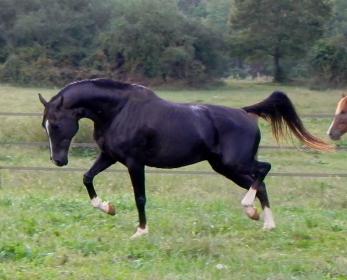
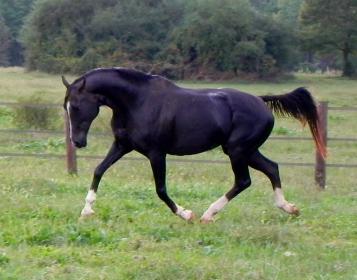
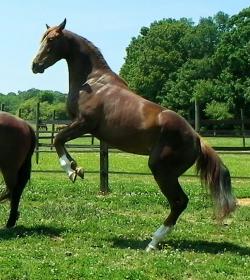
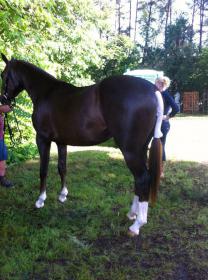
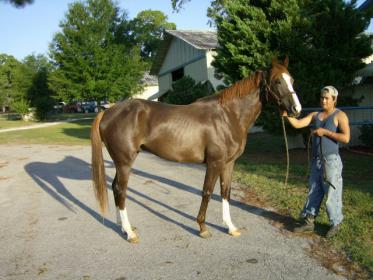
[QUOTE=JB;7395240]
Brown is another variation of Agouti, so still, there has been found no correlation between AA or Aa or aa in the shade of chestnut. Or rather, I should say, there is nothing so far that proves its effect.
A friend of mine has a very pale chestnut -she looks like she is red dun, has many dun factors, but tests negative - who is AA. Now - is she really A+A+ - homozygous for wild bay? If so, that would lend some credence to what Gower hypothesized about wild bay making a chestnut light. Sadly, there is no test for wild bay 
There are also livers who test AA - I don’t know if they are actually AAt or AtAt though.
There simply aren’t enough chestnuts tested for Agouti to have a better handle on it.
Sooty is another issue at play - not testable, but also hypothesized to have a strong effect and can actually turn some chestnut hairs black - a few to a lot, and the “a lot”, if it’s sooty, can be seen in the Morgan breed where they are infamous for “black chestnuts” and extremely dark palominos
Here’s another chestnut who is a pretty normal shade, and is tested AA
https://fbcdn-sphotos-e-a.akamaihd.net/hphotos-ak-frc1/272515_10150219792931748_2446625_o.jpg
This one is pretty much the same shade but is Aa
https://fbcdn-sphotos-d-a.akamaihd.net/hphotos-ak-snc7/471055_10150839109406748_1147627570_o.jpg
So, that goes towards disproving that wild bay would make a chestnut light, and that bay or brown would make it closer to liver.
I will have to double check on this, but I THINK I read somewhere that breeding chestnut to palomino to produce a liver was best done by breeding a lighter, “clear” palomino, if that makes sense. I really need to check that.[/QUOTE]
This is why I hate non-standard presentations of these things. I mis-read how the Agouti is being listed. The AaAa (can’t figure out how to do the superscript) actually means “aa”, not “AA” as I thought. So, my comments above are a 180 of what they would really mean.
[QUOTE=alliekat;7396754]
One of my all time favorite colors is Liver too. Out Tb mare is very dark when kept in out of the sun. She has had several chestnut foals that I am aware of, all a different color of chestnut.
First two are pics of her the other three are of a few of her foals. I love the color of her colt (last pic and please excuse the fact he is not stood up properly, it was taken by the racing track stable hands for his owner).[/QUOTE]
She and her youngsters are gorgeous!
[QUOTE=twelvegates;7395917]
Anyone ever heard of the “black liver chestnut”?
http://irishhuntersandjumpers.com/DreamsComeTrue2012.html[/QUOTE]
That horse is one we bred and raised - still have him, for that matter. I call him “black liver” as his coat is SOOOO dark - many people assume he is black (he is NOT) and it is an accurate descriptive term for his unusual coloration. ALL of his dam’s foals were born chestnut of some kind, though she is a clear medium bay - go figure. Dreamer’s sire was registered as “dark bay/brown” though his owner insists he is black. Having seen and handled that horse, he’s not, true blacks do not have tannish patches in their flanks or on their face, and keeping them clipped down to the hide doesn’t change it :).
Dreamer was foaled the funny grulla shade that many true blacks start out with. I talked with a long-time Morgan breeder when our horse was a yearling and it was becoming apparent that he was NOT black; it was that man who told me the coat color and tail pattern was pretty common in some lines of the Morgan breed.
As an adult, his summer coat bleaches badly if he’s not kept covered.
https://www.facebook.com/media/set/?set=a.10151539115261727.1073741831.252073696726&type=3
If he’s kept in or covered, it is a glorious shade of eggplant - really  with the silvery tail he’s quite striking. His winter coat is deep, fuzzy and very dark - black.
with the silvery tail he’s quite striking. His winter coat is deep, fuzzy and very dark - black.
He’s a handsome guy regardless of the paint job 
https://www.facebook.com/media/set/?set=a.10151398403106727.1073741827.252073696726&type=3
"][IMG]http://i13.photobucket.com/albums/a256/morgansnmind/Rambling%20Brook%20Fantasia/IMG_4569.jpg)
Almost black but she was out in the sun some so started fading and red is starting to show.
http://i13.photobucket.com/albums/a256/morgansnmind/Rambling%20Brook%20Fantasia/molly32.jpg
I got two liver chestnuts (full siblings) from a bay mare and a bay-gone-grey stallion. The second one started lighter and has darkened every year. I did not know chestnuts did this.
